A short technical review
by Peter Murphy
This magnificent volume by Aidan Hart is just what the English-speaking icon-painting community have been crying out for. It is a comprehensive survey of both icon- and wall-painting techniques which is exhaustive in its attention to detail. Using the text and excellent illustrations and photographs it is possible to follow the creation of a traditional Byzantine icon or fresco from sourcing the wooden panel or preparing the wall to photographing the finished work correctly for publication. Perhaps of equal importance, the technical aspect of the book is superbly supported by some astute theological and historical contextualization. I read with great personal pleasure, for example, the author’s detailed account of the Western tradition and the emerging importance of Romanesque painting as a valuable reference point for contemporary iconographers.
![]() The book examines the theological importance of the icon from the viewpoint of the Orthodox Church and the central role the icon plays in underpinning the crucial doctrine of the incarnation by ‘bringing about participation, encounter, communion’. The book also expands to explain the role of the icon in the liturgy and the importance of understanding the decorative schema of an Orthodox church and the role that this scheme plays in uniting the congregation past and present, lay and clergy, in a timeless act of worship. The symbolism of the iconostasis and what it represents and cycles of wall paintings suitable for different types of church building are explained with clarity and an emphatic depth of understanding. For many of the people who will purchase this book I should imagine one of the primary factors in judging its success or otherwise, is if the technical procedures, lovingly described by the author, actually work as a practical, ‘how to’ guide for painting an icon. To this end I decided to put the author’s description of how to paint an icon using the ‘membrane’ technique to the test. I have been painting icons for many years and have always used the well-tried and tested ‘proplasmos’, or ‘first skin/layer’ technique, as this was the way I was taught to do it. The author’s research has led him to the conclusion that the ‘membrane’ technique is an extremely ancient method which may in fact pre-date the use of the more common ‘proplasmos’ technique.
The book examines the theological importance of the icon from the viewpoint of the Orthodox Church and the central role the icon plays in underpinning the crucial doctrine of the incarnation by ‘bringing about participation, encounter, communion’. The book also expands to explain the role of the icon in the liturgy and the importance of understanding the decorative schema of an Orthodox church and the role that this scheme plays in uniting the congregation past and present, lay and clergy, in a timeless act of worship. The symbolism of the iconostasis and what it represents and cycles of wall paintings suitable for different types of church building are explained with clarity and an emphatic depth of understanding. For many of the people who will purchase this book I should imagine one of the primary factors in judging its success or otherwise, is if the technical procedures, lovingly described by the author, actually work as a practical, ‘how to’ guide for painting an icon. To this end I decided to put the author’s description of how to paint an icon using the ‘membrane’ technique to the test. I have been painting icons for many years and have always used the well-tried and tested ‘proplasmos’, or ‘first skin/layer’ technique, as this was the way I was taught to do it. The author’s research has led him to the conclusion that the ‘membrane’ technique is an extremely ancient method which may in fact pre-date the use of the more common ‘proplasmos’ technique.
On the day that I received my copy of the book I had already completed a small head and shoulders icon of St Anthony Abbot as far as having the gilding applied and burnished, and I decided to complete it in the ‘membrane’ technique.
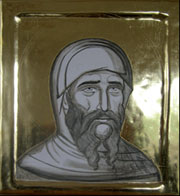
Fig. 1
As per the instructions for painting the head of St Joseph on page 235 of the book, I started with a monochromatic tonal brush drawing using verdaccio (Fig. 1).
It is important at this stage to leave the areas to be highlighted later with the white of the panel showing.
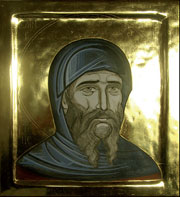
Fig. 2
I then completed the clothing using a translucent proplasmos technique, stepping up from a transparent wash of terre verte, verdaccio, and a little French ultramarine through grey and finally white highlights (Fig. 2).
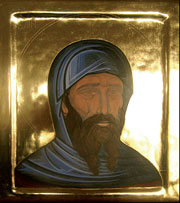
Fig. 3
Next I put the ‘membrane’ layer of transparent yellow ochre, titanium white, and English light red over the face. This should be built up in several washes, so that although transparent it is even all over (Fig. 3).
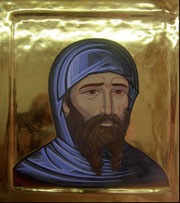
Fig. 4
Then I put in the first highlights using yellow ochre and white and redrew details like the eye lines (Fig. 4).
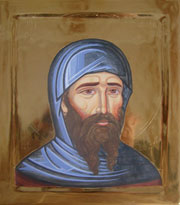
Fig. 5
Then came second highlights using yellow ochre and more white, first eye highlights using raw umber and white and washes of red brown over the iris with a black pupil.
At this stage I introduced some delicate washes of English light red into the cheeks, down the side of the nose, in the tear gland and for the mouth, and added two more layers of highlighting, the final highlights being pure white (Fig. 5).
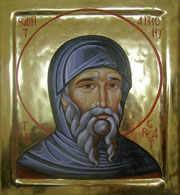
Fig. 6
After this I worked through the beard using three successively lighter layers of burnt umber and white, being careful to give the beard movement and volume using precise directional highlighting strokes. I added the same highlights to the eyebrows and put the second white highlights in the eyes, the final touch being to put in the halo line and the inscription (Fig. 6).
In conclusion I am pleased to say that overall I find the book is an outstanding triumph, a well-balanced synthesis of incredibly helpful practical instruction, combined with a profound theological and fascinating historical exploration of all aspects of Byzantine iconography.
—
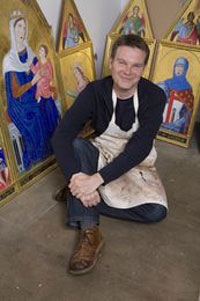
Peter Murphy
www.petermurphyicons.co.uk
Peter Murphy (born 1959 in Leeds), moved to Liverpool and later Durham. Educated at Jacob Kramer College of Art and the University of East London. Trained with iconographer Guillem Ramos-Poqui in London. Murphy uses traditional techniques from medieval religious painting, including egg tempera paint and gold leaf. He was Vice Chairman of the Society of Tempera Painters and is a member of The British Association of Iconographers, He runs courses in the UK, Greece and Italy teaching these techniques and has been commissioned by a number of churches in the UK, notably Tewkesbury Abbey and Hereford Cathedral. He has also been employed by a number of museums for special exhibitions, he has recreated a triptych by Simone Martini for The Barber Institute of Fine Arts and created a mural of ten scenes from the life of Benedict Biscop for Bede’s World Museum in Jarrow. He was one of a team on a Rolf Harris TV show which recreated a Botticelli painting in a week. He has recently completed a third major commission for Hereford Cathedral
